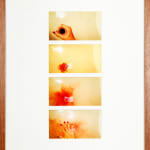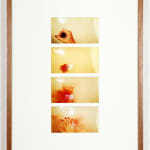Aleta Valente
Desvio para o Vermelho, 2019
impressão pigmentada sobre papel Canson Rag Photographique 310gr [pigmented print on Canson Rag Photographique 310gr]
53 x 42,5 x 4 cm [20 7/8 x 16 3/4 x 1 5/8 in]
2.2 kg
2.2 kg
Edition of 6 plus 2 artist's proofs
Série de quatro fotografias que expõe o movimento de um elemento natural do corpo humano em contato com a água. As fotografias foram realizadas enquanto a artista entornava o coletor...
Série de quatro fotografias que expõe o movimento de um elemento natural do corpo humano em contato com a água. As fotografias foram realizadas enquanto a artista entornava o coletor menstrual com seu próprio sangue em uma banheira cheia d'água em alusão aos comerciais e propagandas de absorventes íntimos que utilizam um líquido azul e com cheiro de flor para amenizar as características dos fluidos do corpo. O sangue feminino é historicamente marginalizado e a recusa do discurso amplo e da estética da menstruação marcam a domesticação e infantilização das características do corpo feminino na sociedade patriarcal e machista.
Series of four photographs that exposes the movement of a natural element of the human body in contact with water. The photographs were taken while the artist spilled the menstrual collector with her own blood in a tub full of water alluding to commercials and advertisements for tampons that use a blue, flower-smelling liquid to soothe the characteristics of body fluids. Female blood is historically marginalized, and the refusal of broad discourse and menstrual aesthetics marks the domestication and infantilization of the characteristics of the female body in patriarchal and chauvinist society.
Series of four photographs that exposes the movement of a natural element of the human body in contact with water. The photographs were taken while the artist spilled the menstrual collector with her own blood in a tub full of water alluding to commercials and advertisements for tampons that use a blue, flower-smelling liquid to soothe the characteristics of body fluids. Female blood is historically marginalized, and the refusal of broad discourse and menstrual aesthetics marks the domestication and infantilization of the characteristics of the female body in patriarchal and chauvinist society.



